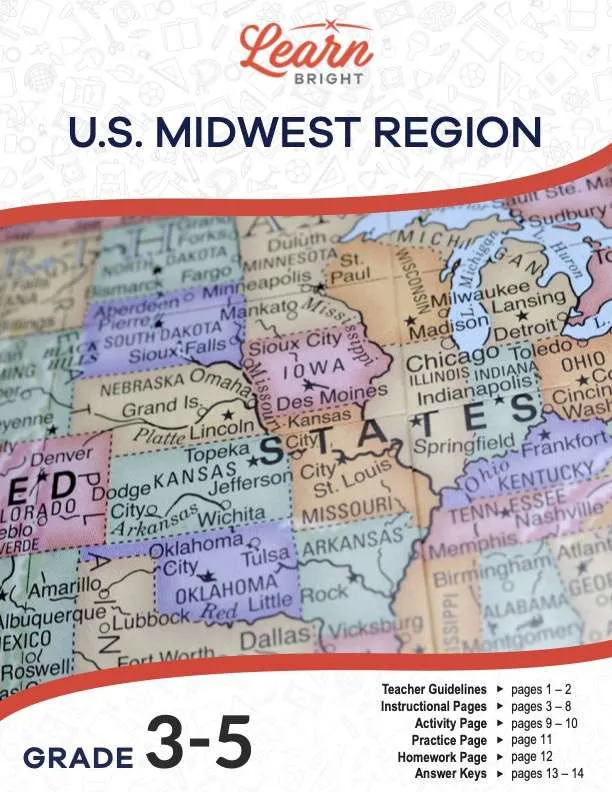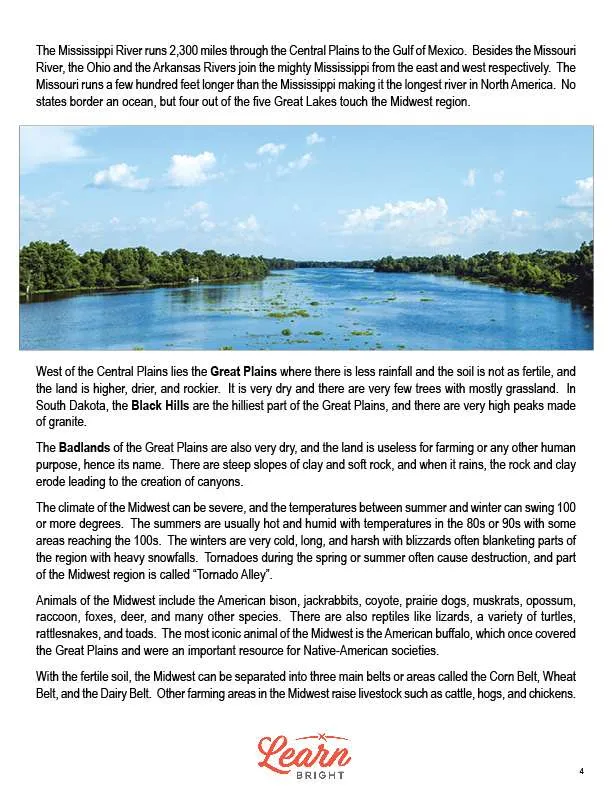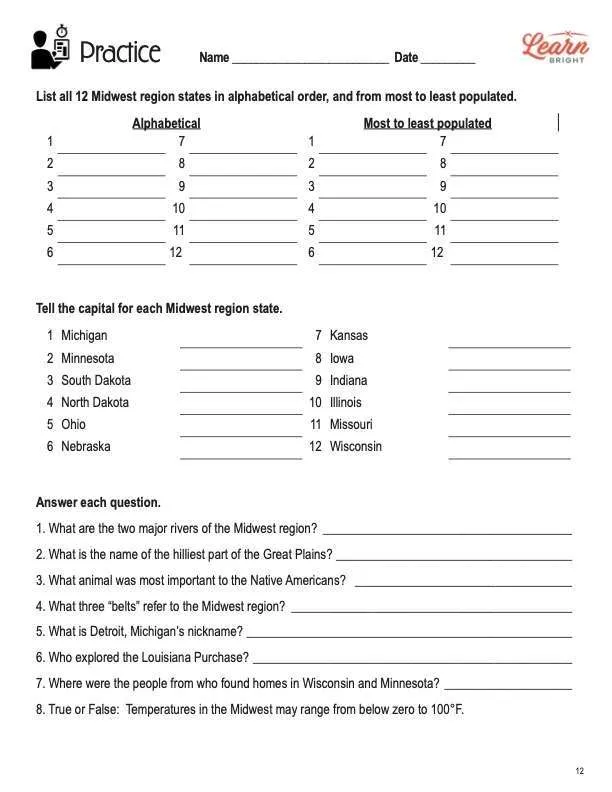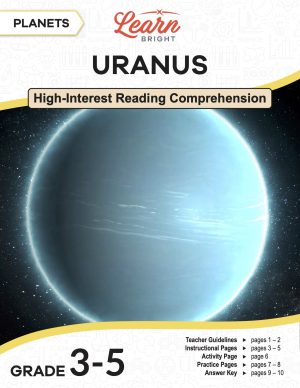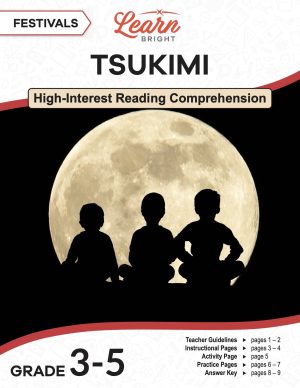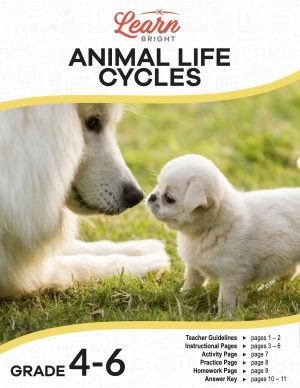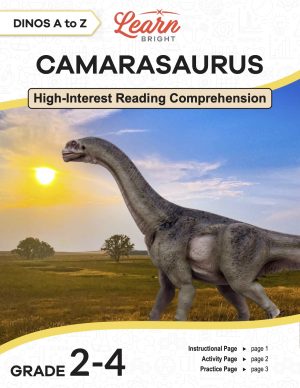Description
What our United States Midwest Region lesson plan includes
Lesson Objectives and Overview: United States Midwest Region describes the states that make up the “Heartland” of the nation. The Midwest does not have too much variety when it comes to landscapes, unlike other regions. This lesson is for students in 3rd grade, 4th grade, and 5th grade.
Classroom Procedure
Every lesson plan provides you with a classroom procedure page that outlines a step-by-step guide to follow. You do not have to follow the guide exactly. The guide helps you organize the lesson and details when to hand out worksheets. It also lists information in the yellow box that you might find useful. You will find the lesson objectives, state standards, and number of class sessions the lesson should take to complete in this area. In addition, it describes the supplies you will need as well as what and how you need to prepare beforehand.
Options for Lesson
In the “Options for Lesson” section of the classroom procedure page, you will see some suggestions for additional activities or ideas to add to the lesson if you want to. Students may work alone or in groups for the activity. Create a multiple-choice quiz using the facts from the activity. Conduct a spelling bee using the names of states, capitals, and cities, but students must identify the state for each city. Assign each pair of students a state to conduct further research and later present to the class. Give students blank US maps, and have them identify and label each midwestern state. They can also include the cities, rivers, etc. Students create a board game in the shape of the midwest region, including game pieces, question cards, etc.
Teacher Notes
The paragraph on this page provides a little more information or guidance on what to expect from the lesson. It mentions that students should be aware of each region of the country. You can use the blank lines to record any thoughts or ideas you have as you prepare.
UNITED STATE MIDWEST REGION LESSON PLAN CONTENT PAGES
States of the Midwest
The United States Midwest Region lesson plan contains six pages of content. There are 50 states that compose the United States of America. However, we often divide the country into five geographic regions: northeast, midwest, west, southwest, and southeast. Of course, it is still a single country. However, the different regions share similar characteristics. For instance, they might share similar natural or artificial features such as language, government, ideology, religion, forests, wildlife, and climate.
The Midwest region of the United States includes twelve states. These states are Illinois, Iowa, Indiana, Kansas, Michigan, Minnesota, Missouri, Nebraska, North Dakota, Ohio, South Dakota, and Wisconsin. The region is often called the Heartland of America or America’s Breadbasket. This is because of its location.
Geographically speaking, the states that make up the Midwest are at the center or heart of the country. The region is the center of both farming and industry. Many products Americans use every day come from the area. It is called the Breadbasket because farmers produce a lot of wheat throughout the region that people use for making bread or other food products.
Geography
The Midwest is much different than the other regions of the country. The landscape looks like mostly flat, rolling land with very few trees. We call this area the Central Plains. Prairie grasses cover much of the land, which helps make the soil extremely fertile for farming. The plains are low but rise slowly west of the Mississippi River. The Mississippi and Missouri Rivers make two important waterways.
In fact, the Mississippi River runs 2,300 miles through the Central Plains to the Gulf of Mexico. Besides the Missouri River, the Ohio and the Arkansas Rivers join the mighty Mississippi from the east and west respectively. The Missouri runs a few hundred feet longer than the Mississippi, making it the longest river in North America. No states border an ocean, but four out of the five Great Lakes touch the Midwest region.
West of the Central Plains lies the Great Plains where there is less rainfall and where the soil is not as fertile. In the Great Plains, the land is higher, drier, and rockier. It is very dry and there are very few trees with mostly grassland. In South Dakota, the Black Hills are the hilliest part of the Great Plains. And there are very high peaks made of granite.
The Badlands of the Great Plains are also very dry. The land there is useless for farming or any other human purpose, hence its name. There are steep slopes of clay and soft rock. When it rains, the rock and clay erode, leading to the creation of canyons.
Climate and Wildlife
The climate of the Midwest can be severe, and the temperatures between summer and winter can swing 100 or more degrees. The summers are usually hot and humid with temperatures in the 80s or 90s, some areas reaching the 100s. The winters are very cold, long, and harsh. Blizzards often blanket parts of the region with heavy snowfalls. Tornadoes during the spring or summer often cause destruction. In fact, part of the Midwest region is called “Tornado Alley.”
Animals of the Midwest include the American bison, jackrabbits, coyote, prairie dogs, muskrats, opossum, raccoon, foxes, deer, and many other species. There are also reptiles like lizards, a variety of turtles, rattlesnakes, and toads. The most iconic animal of the Midwest is the American buffalo, which once covered the Great Plains and were an important resource for Native-American societies.
With the fertile soil, the Midwest separates into three main belts or areas called the Corn Belt, Wheat Belt, and the Dairy Belt. Other farming areas in the Midwest raise livestock such as cattle, hogs, and chickens. Finally, the region has large deposits of iron ore, which is used in steelmaking. This is especially relevant in the manufacturing of cars and trucks. In fact, the city of Detroit, Michigan, earned the nickname Motor City and is the center of the automobile industry of America.
History of the Midwest
During the Treaty of 1783, the land east of the Mississippi River was designated as the Northern Territory when the British received it. The Louisiana Purchase in 1803 included the land west of the Mississippi River. Members of the Lewis and Clark expedition explored the area beginning in 1804. Many settlers in the east sought better farmland, so they traveled west.
Many Europeans bypassed the east coast and immediately headed west. The immigrants included those from Germany who settled in eastern Missouri. A large population of people from Sweden and Norway found homes in Wisconsin and Minnesota. Other people from the northeast, including Pennsylvanians and Northern Europeans, also came to the midwest region throughout the early 19th century.
There were many Native Americans who had already settled in the Midwest region many years earlier. The Great Lakes region included the Hurons, Ottawa, Chippewas, and many others. Most are of the Algonquian language family. The Great Plains Native Americans included the Blackfoot, Arapaho, Sioux, Cheyenne, Comanche, and Apache. Among the most powerful and dominant tribes were the Dakota and Sioux. They occupied large areas of land in the Great Plains of the Midwest. The Great Sioux Nation spread throughout the south and the rest of the midwest region.
Traits of the States
The lesson provides a chart that lists the 11 states of the Midwest along with information about each one. This includes the population as of 2021, rounded to the nearest thousand. Illinois is the Prairie State and is a big railroad center. It is home to memorials of Abraham Lincoln, including the Lincoln Tomb.
Iowa is the Hawkeye State, and it’s primarily an agricultural state. It is home to an Indian burial site at Marquette. Indiana boasts attractions like the Indianapolis Motor Speedway and Wyandotte Cave. Kansas has several military compounds, including Fort Leavenworth and Fort Riley. The state is home to nearly 3 million people.
Michigan is famous for the automobile plants in Detroit. It also touches several of the Great Lakes. Popular cities include Ann Arbor, Grand Rapids, and Lansing. Minnesota also touches some of the Great Lakes. In fact, people recognize the state as the Land of 10,000 Lakes. One of its major attractions is the St. Paul Winter Carnival.
Missouri is home to the famous Gateway Arch in St. Louis, as well as country music shows in Branson. It was also Mark Twain’s boyhood home. Nebraska, the Cornhusker State, has several historical attractions, such as the Scotts Bluff National Monuments and the Chimney Rock National Historic Site.
In North Dakota, you would find the International Peace Garden and Theodore Roosevelt National Park. Ohio is home to the Rock and Roll Hall of Fame, and some Indian burial grounds. South Dakota boasts the Mt. Rushmore monument of the four presidents carved in granite. And in Wisconsin, you can find around 14,000 lakes, the Ice Age National Scientific Reserve, and the Circus World Museum.
UNITED STATES MIDWEST REGION LESSON PLAN WORKSHEETS
The lesson plan includes three worksheets: an activity worksheet, a practice worksheet, and a homework assignment. Each one will reinforce students’ comprehension of lesson material in different ways and help them demonstrate when they learned. Use the guidelines on the classroom procedure page to determine when to distribute each worksheet to the class.
CUT AND PASTE ACTIVITY
The activity will take a little bit of time. Students will cut out each of the letters on the worksheet. They will then arrange the letters to spell each of the 12 states they just learned about. Next, they will glue the letters to a poster board. Finally, they will represent two facts about each state using words or drawings.
UNITED STATES MIDWEST REGION PRACTICE WORKSHEET
For the practice worksheet, students will list the states in alphabetical order. Then they will order them by population, most to least. After that, they will write the capital for each state. Last, they will have to answer eight questions based on the lesson.
MATCH THE STATE HOMEWORK ASSIGNMENT
The homework assignment requires students to match states to corresponding landmarks, cities, and facts. They will have to remember what they learned throughout the lesson. There are also six numbers that have some significance to the Midwest region. Students will have to describe what each of the numbers mean.
Worksheet Answer Keys
There are answer keys for the practice and homework pages at the end of the lesson plan document. The correct answers are all in red to make it easier to compare them to students’ responses. If you choose to administer the lesson pages to your students via PDF, you will need to save a new file that omits these pages. Otherwise, you can simply print out the applicable pages and keep these as reference for yourself when grading assignments.

